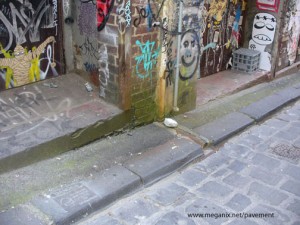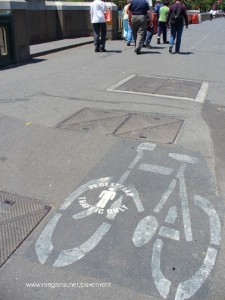 There is an ongoing battle between cyclists and just about everyone else – motorists don’t want them on the roads, pedestrians (like me) don’t want them on the footpaths. The issue is a perennial filler for Sydney newspapers and has flared again this week in news stories, opinion pieces and letters to the editor.
There is an ongoing battle between cyclists and just about everyone else – motorists don’t want them on the roads, pedestrians (like me) don’t want them on the footpaths. The issue is a perennial filler for Sydney newspapers and has flared again this week in news stories, opinion pieces and letters to the editor.
In Australia, those who argue on the cyclists’ side point to the way in which cities in other developed countries have embraced the bicycle – but it’s not necessarily all plain cycling overseas. Apparently one of the great battlefields in the war between bicyclists, pedestrians and motorists is the Brooklyn Bridge in New York. Robert Sullivan, calling for an armistice, writes in the New York Times: “The stripe painted down the center of the elevated Brooklyn Bridge walkway, to separate bicyclists from pedestrians, has become a line in the sand. We need to erase that line once and for all.†Here is an example where the record of a territorial struggle has been written on the pavement itself.
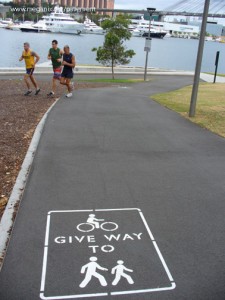 Almost every sign, symbol, graphic and graffiti marked on the roads and sidewalks is a claim for territory. The two examples photographed for today’s blog record instances where pedestrians have had a victory over cyclists, officially at least, and probably only temporarily. The ineptly obliterated bicycle symbol overpainted with a ‘Pedestrian traffic only’ stencil was on the bridge at the corner of St Kilda Road and Flinders Street in Melbourne in 2005. The ‘Give way’ stencils appeared in parks in the City of Sydney towards the end of 2008 after many complaints from pedestrian park-users.
Almost every sign, symbol, graphic and graffiti marked on the roads and sidewalks is a claim for territory. The two examples photographed for today’s blog record instances where pedestrians have had a victory over cyclists, officially at least, and probably only temporarily. The ineptly obliterated bicycle symbol overpainted with a ‘Pedestrian traffic only’ stencil was on the bridge at the corner of St Kilda Road and Flinders Street in Melbourne in 2005. The ‘Give way’ stencils appeared in parks in the City of Sydney towards the end of 2008 after many complaints from pedestrian park-users.
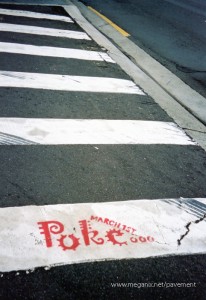 The Dictionary of Sydney was launched on 4 November 2009. It’s an on-line encyclopaedia of the history of Sydney with new material being added continually. The range of subjects is broad and sometimes surprising. Along with such conventional topics as, say, Governor Lachlan Macquarie or the Japanese Submarine Attack, there are such entries as Drag and Cross Dressing, and The Royal Commission into Noxious and Offensive Trades, and even (ta-da!) Reading the Roads.
The Dictionary of Sydney was launched on 4 November 2009. It’s an on-line encyclopaedia of the history of Sydney with new material being added continually. The range of subjects is broad and sometimes surprising. Along with such conventional topics as, say, Governor Lachlan Macquarie or the Japanese Submarine Attack, there are such entries as Drag and Cross Dressing, and The Royal Commission into Noxious and Offensive Trades, and even (ta-da!) Reading the Roads. There is an ongoing battle between cyclists and just about everyone else – motorists don’t want them on the roads, pedestrians (like me) don’t want them on the footpaths. The issue is a perennial filler for Sydney newspapers and has flared again this week in news stories, opinion pieces and letters to the editor.
There is an ongoing battle between cyclists and just about everyone else – motorists don’t want them on the roads, pedestrians (like me) don’t want them on the footpaths. The issue is a perennial filler for Sydney newspapers and has flared again this week in news stories, opinion pieces and letters to the editor. Almost every sign, symbol, graphic and graffiti marked on the roads and sidewalks is a claim for territory. The two examples photographed for today’s blog record instances where pedestrians have had a victory over cyclists, officially at least, and probably only temporarily. The ineptly obliterated bicycle symbol overpainted with a ‘Pedestrian traffic only’ stencil was on the bridge at the corner of St Kilda Road and Flinders Street in Melbourne in 2005. The ‘Give way’ stencils appeared in parks in the City of Sydney towards the end of 2008 after many complaints from pedestrian park-users.
Almost every sign, symbol, graphic and graffiti marked on the roads and sidewalks is a claim for territory. The two examples photographed for today’s blog record instances where pedestrians have had a victory over cyclists, officially at least, and probably only temporarily. The ineptly obliterated bicycle symbol overpainted with a ‘Pedestrian traffic only’ stencil was on the bridge at the corner of St Kilda Road and Flinders Street in Melbourne in 2005. The ‘Give way’ stencils appeared in parks in the City of Sydney towards the end of 2008 after many complaints from pedestrian park-users.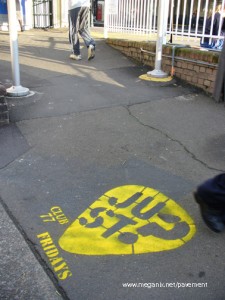 The dance party stencils are getting bigger and bolder. Around the middle of June ads for JUST? at Club 77 were sprayed all over inner-west pavements. Those in the know know where Club 77 is.
The dance party stencils are getting bigger and bolder. Around the middle of June ads for JUST? at Club 77 were sprayed all over inner-west pavements. Those in the know know where Club 77 is.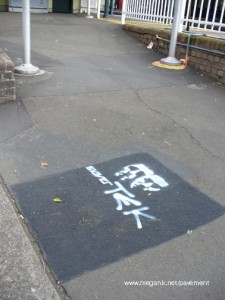
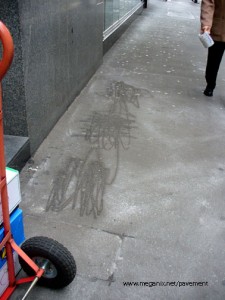 Over the years I have found York Street in the CBD to be a very fruitful site for pavement observation. Last week I spotted this line of scribbles near Barrack Street. These scribbles are not meaninglessÂ
Over the years I have found York Street in the CBD to be a very fruitful site for pavement observation. Last week I spotted this line of scribbles near Barrack Street. These scribbles are not meaningless 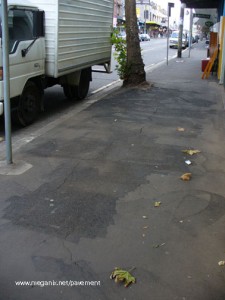
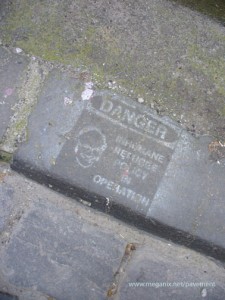 Even if you weren’t a graffiti aficionado you would probably recognize that this is somewhere in Melbourne because of the bluestone cobbles. It’s Hosier Lane in November 2005. Amongst the different styles of wall graffiti there is one stencil on the kerbstone. ItÂ
Even if you weren’t a graffiti aficionado you would probably recognize that this is somewhere in Melbourne because of the bluestone cobbles. It’s Hosier Lane in November 2005. Amongst the different styles of wall graffiti there is one stencil on the kerbstone. It 